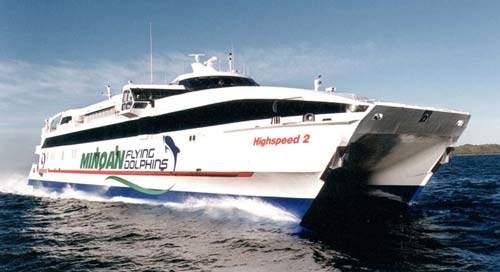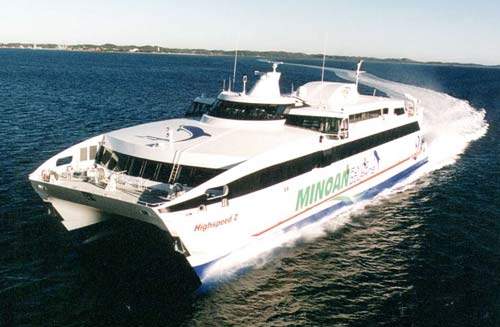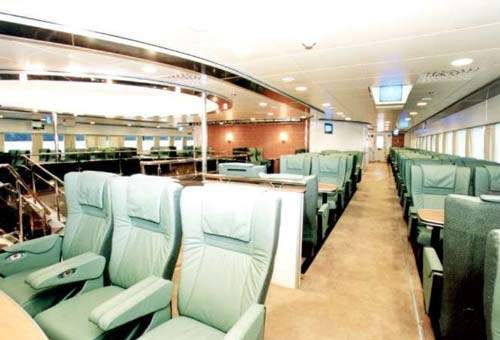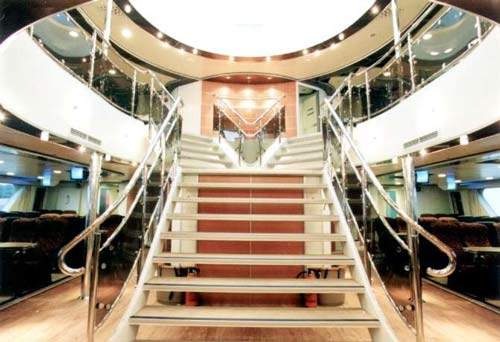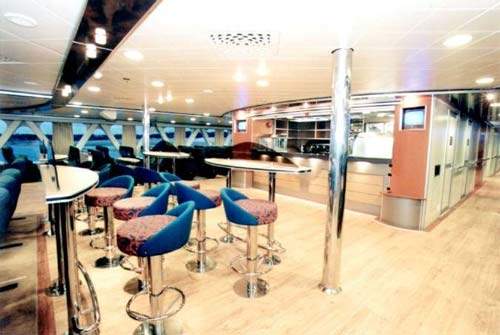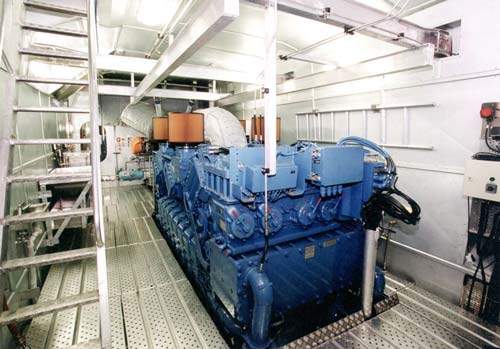Highspeed 2 was the first of two Auto Express 72 catamarans ordered by Minoan Flying Dolphins from Austal ships. The vessel was delivered in June 2000 and is deployed in the Aegean Sea.
Highspeed 2 flies the Greek flag and is classed by Germanischer Lloyd.
DESIGN
Highspeed 2 is the first vessel built by Austal to be delivered with a Seastate TMAX system. The system takes over control from the vessel’s waterjets at speeds in excess of 25 knots, allowing all waterjet thrust to be vectored forward for maximum propulsive thrust and eliminating waterject bucket drag. Seastate estimates that the system provides average service speed improvements in excess of 2 knots in rough seas.
FACILITIES
Highspeed 2 accommodates passengers in three classes of seating; 112 VIP seats in the upper saloon, 128 business class seats forward on the main deck and 407 tourist class seats. There are also 28 external seats in a covered area aft on the main deck.
The vessel has 1,250m² dedicated to passengers and support services. Amitco flooring with an ‘oak timber’ look is used extensively in heavy traffic areas. The main passenger deck has two kiosk/restaurant areas, a children’s playroom, a games room and toilet facilities. A shopping area and information counter is located amidships and baggage racks are positioned in the saloons. Reclining Beurteaux Australia seats on the main deck are configured in a combination of airline and table arrangements.
The business class area features panoramic windows forward across the superstructure. A staircase beneath the central atrium on the main deck leads to the VIP lounge, providing leather seating with sound system controls in the arm rests that offer a selection of five audio channels. There are also 24 individual game systems mounted in the seats.
Two Liferaft Systems Australia MES stations are located forward to port and starboard, and two 4.2m inflatable rescue boats are stowed aft on the bridge deck. Austal has stated that during harbour deployment trials, 184 people were successfully evacuated from Highspeed 2 in under 11 minutes – nearly seven minutes faster than the required time.
The vessel has two independent passenger gangways to ensure safer and faster passenger loading. The two gangways are a fixed length, raised and lowered hydraulically, and have been designed to operate simultaneously with or independently from the vehicle ramp. The gangways and the length of the ramps have been designed to suit the typically low jetties found in the Aegean Islands.
All ships operating in the Aegean must be capable of anchoring stern to the jetty. To achieve this, a fast anchoring system was designed. The anchor and chain sizes on the Highspeed 2 have been increased substantially from the sizes required by both the classification and flag authority requirements.
To complement the anchoring system in the bow, the equipment on the aft mooring deck has also been upgraded. Two large high-speed mooring warp drums are installed on each deck. They are capable of moving the stern of the vessel into position, using ropes that are permanently fitted to the drum. The winches also have a high no-load line recovery speed. Mooring warps fitted to the winches run through custom-built Panama fairleads to ensure low rope wear.
PROPULSION
Highspeed 2 has four MTU 16V 595 TE70L diesels, rated at 3,866kW at 1,750rpm, driving Kamewa 90 SII waterjets via Reintjes VLJ 2230 gearboxes. When operating at 90% MCR and carrying 130dwt, the service speed is 39 knots.
Electronics in the wheelhouse include Kelvin Hughes radars, Nucleus 5000 II and Nucleus 2 Ecdis navigational equipment and electronic chart navigation, C.Plath gyro and magnetic compasses, Sailor and ICOM communications systems and a Vistar night vision system.

